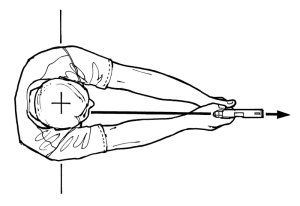Super Airguns
 This is an excerpt of an article that will appear in an upcoming issue of Western Shooting Journal.
This is an excerpt of an article that will appear in an upcoming issue of Western Shooting Journal.
By Ron Gill
At the 2013 Extreme Benchrest airgun tournament, in Green Valley, Arizona, I saw more super air guns than I ever expected to see in one place at one time.
Super pellet guns? Yes, powerful ones in larger calibers and higher muzzle energies than we remember. With airgun velocities, like all firearms, faster is better; but a pellet becomes unstable as its velocity approaches the speed of sound. Remember how the aircraft shook before it broke the sound barrier in The Right Stuff? To get more energy into a pellet to shoot further, buck the wind better and hit harder, airgun designers increase pellet weight to carry more energy and stay well below transonic velocities. But pellet weight can only be increased so much; just over 20 grains is the practical limit for .22 pellets. To get pellet weight up to say 30 grains, many manufacturers, including our preteen friend, Benjamin, offer .25 caliber air rifles, and some make .30 caliber guns that shoot 50 grain pellets.

The air rifles we remember got their power from pumping before each shot or from CO2 capsules, but nearly all of the super air rifles are pre-charged pneumatics that store high pressure compressed air up to 3500 psi for several shots before being topped up from a tank or a special pump. The volume of storage and the volume of air used to fire a pellet determine how many shots can be taken before the on-board storage has to be refilled. Higher storage pressures and larger storage vessels equal more shots. Higher velocities and larger bores equal fewer shots. Airgunners, on the range or in the field, must balance strategy with power.
How powerful?
The .30 caliber FX Boss , a common rifle of the top twenty shooters at Extreme Benchrest, shoots a 46.3 grain pellet at 874 feet per second (78 foot pounds of muzzle energy). When I was a kid, the hottest air rifle on the block was a Sheridan Silver Streak. This rifle shot a 14 grain pellet at 740 fps and churned up a whopping 17 foot pounds. That is still enough to be classed as a firearm in many European countries, but compared to the Boss, it’s a wimp. The Daystate Air Wolf, the next most represented in the top twenty, is a .25 that shoots a 25 grain pellet up to 850 fps. Super air guns are also made in the United States. There were several .25 caliber HM1000Xs, made by Rapid Air Weapons in Tennessee, that are rated at 55 foot pounds. That’s 995 fps with a 25 grain pellet. My Benjamin Marauder reaches 42 foot pounds with pellets ranging from 25 to 31 grains. Viewed from the vantage point of the airguns we knew as kids, that is mighty powerful.
These new super air rifles are more than powerful. They are accurate. Winning shooters in Arizona had the majority of their hits in or touching the ½ inch ten ring in the 75 yard benchrest match. That works out to a head shot on a squirrel or a rabbit at the same range. This kind of shooting also requires judging the wind to a pellet’s width, because even at 900 feet per second the wind will nudge a pellet toward the edge of the target.

Can an air gun be “hand loaded” to improve performance?
Of course. Air gunners today do the same thing: pressurizing their guns to where the gun shoots best, and adjusting the firing valve to tweak the pressure and volume of the air flowing into the barrel. Sometimes this can be done by turning a screw, but other times it requires custom machining by a hand that is no less skilled than one that tunes the finest firearms. Lastly, pellet selection is absolutely key to getting the best performance. Selection is primarily for weight. In .25 caliber, for example, common weights vary from 24 grains to 31. Airgunners are looking for the combination of weight and velocity that yield the best accuracy and wind resistance.
What kind of air rifle does it take to shoot in the top ranks? A quality air rifle that will group its pellets into about ¾ inch, at 75 yards. Power, you bet, 50+ foot pounds of muzzle energy would be nice. That’s three times the power of the Sheridan Silver Streak you wanted when you were in the sixth grade. Heavy pellets to carry all that power at velocities below the transonic speeds that buffet a pellet out of alignment with the cross hairs. A scope powerful enough to spot shot holes without having to take time to use a spotting scope, and reticules with dots or stadia marks to measure and compensate for the wind’s deflection. Sounds like a kid talking to Santa doesn’t it?
What does a winning super air rifle look like?
It is really not much different from that old Sheridan or Crosman in your closet. The pump that our preteen bodies struggled with is replaced with an air storage cylinder or a diver’s buddy bottle to hold the air supply for shooting. The rest of the gun looks about the same, but is engineered to handle higher pressures and built to a higher standard of fit and finish. Add a high density synthetic or well-figured walnut stock, and the asking price will hover over two grand. Not a bad price for a competition firearm, but in the hunting/target airgun world it is in the stratosphere.
Editor’s note: Ron Gill is a retired wildlife biologist and Vietnam veteran. A lifelong shooter, Ron’s attitude toward guns is,“If it goes bang, I love it.” Ron is the president of the Idaho Airgun Field Target club and has written for several airgun publications and web sites. Ron blogs about airguns at blueflaxairguns.blogspot.com.



